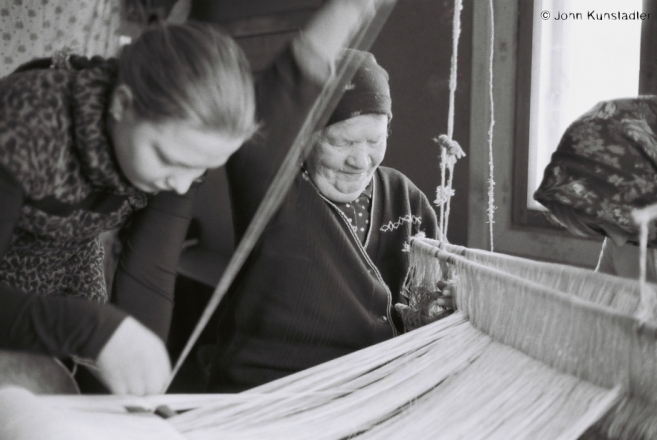The Loom III. Кросны (частка ІII).
In previous generations the loom was an essential Polesian household fixture. But weaving was an arduous task. Granny Vul’ljana recalls how women and girls would exhaust themselves weaving long into winter nights to produce enough cloth for the coming year. Now, she notes, only three looms remain in the village of Tsjerablichy in Polesia’s Central Prypjats’ region. One is hers.
Granny Vul’ljana, like every other Belarusan grandmother I’ve ever met, never stops working. Like every other Belarusan grandmother I’ve ever met, she is the backbone of her family, her village, her country. Late in 2010 she fell seriously ill for the first time in her life, and the resulting forced slowdown was a blow to her morale. To regather her energy, and at her granddaughter Vjera’s request to pass on loom-assembly and weaving skills, Granny Vul’ljana and Vjera re-assembled the loom. It was inspiring to see another granddaughter, 13-year-old Tanja, carefully help thread the warp. One she was seated, Granny Vul’ljana’s face radiated more and more energy and joy with each thrust of the shuttle, with each shift of the treadles, with each thwack of the beater as she battened the weft.
See also May 12 and March 22.
Колісь кросны былі ў кожнай палескай хаце. Сёньня ў Цераблічах засталіся толькі ў трох. Ткацтва – цяжкая праца. Бабуля Вульляна ўзгадвала, як узімку жанчыны і дзяўчыны снавалі начамі і поўнасьцю зьнясільваліся, намагаючыся наткаць дастаткова палатна на ўвесь год.
Як кожная беларуская бабуля, бабуля Вульляна не спыняе працы ніколі. І як кожная беларуская бабуля, яна ёсьць апірышчам для сваёй сям’і, малой і вялікай. Напрыканцы 2010 года бабуля Вульляна ўпершыню ў жыцьці сур’ёзна захварэла, і яе “няздатнасьць” моцна падкасіла яе маральна. Трэба было шукаць дзесьці новыя сілы. Бабуля Вульляна з унучкай Верай паставілі кросны; маладзейшая ўнучка Таня старанна і асьцярожна дапамагала наладжваць аснову. І як толькі бабуля за іх села, яе твар пачаў выпраменьваць больш і больш імпэту і радасьці з кожным нырцом чоўніка, з кожным перасоўваньнем паножаў, з кожным ударам набіліцы, што прыціскае ўток.
Гл. таксама 12 траўня й 22 сакавіка.
Tsjerablichy 2011. Цераблічы 2011 год.
